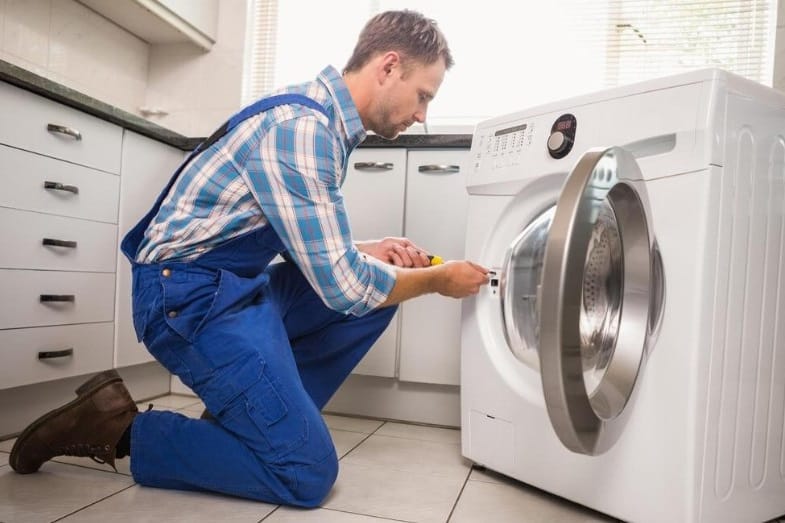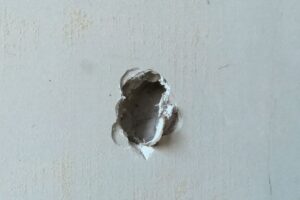Is your clothes dryer not heating properly? This is a common issue for anyone with a dryer. The first instinct when a dryer stops heating is to call a technician, but you may be able to fix it yourself! There are simple dryer repairs that you can do yourself, at least for the most common dryer issues.
One of the most common causes for a dryer not heating is a faulty thermal fuse. The function of this fuse is to cut the flow of electricity going to the electric motor. It is a safeguard against more extensive damage to the electrical parts of the dryer. If the fuse is blown, you need to replace it before you can turn the dryer on.
The full list of 7 causes for a clothes dryer not heating are as follows:
- Incorrect Voltage Delivered to the Dryer
- Blown Fuse or Tripped Circuit Breaker
- Debris from Clothes Blocks the Heating Element
- The Circuit Breaker Has Tripped
- No Gas Flow
- Uneven Loading of Clothes
- Motor Overheating
The 8 repair steps to repair your malfunctioning dryer are as follows:
- Prep Work
- Check the Thermal Fuse
- Check the Thermal Cut Off
- Check the High Limit Thermostat
- Check the Cycling Thermostat
- Check the Heating Element
- Check Other Parts of the Machine
- Replace with the Correct Parts
Read on to learn more about the many issues surrounding a clothes dryer not heating, as well as learn the steps to fix the dryer yourself.
Also, for a replacement or extra dryer, take a look at the Avanti Portable Dryer Front Loading for Laundry,. This dryer is perfect for a smaller condo or apartment. It can dry a maximum of 13 pounds of clothing. It is lightweight and very portable as well.
Click here to see this dryer on Amazon.
Dryer Not Heating? How to Fix Clothes Dryer
A usual problem that many homeowners encounter is their clothes dryer stops heating. One of the most common issues of a dryer not heating is a blown thermal fuse.
The fuse is installed to safeguard the other more critical parts of the clothes dryer. It acts as a circuit breaker. Before these vital and expensive parts get busted, the fuse gets broken first. In this way, the electricity will be cut off right from the entry point, ensuring that only the fuse needs to be replaced.
To replace the fuse, just uncover the back part of the dryer. Locate the fuse and pull it off its socket. Then, replace it with a new one with the same specifications.
There are many other reasons why a dryer is not heating. The rest of this article will provide more detailed information, including some things you can do to make your dryer run again.
If it is too difficult to repair your dryer, you can consider a new dryer such as the Panda Portable Compact Laundry Dryer. This dryer is perfect for a condominium unit or an apartment. It can dry a maximum of 13 pounds of clothing. It is lightweight and very portable as well.
Click here to see this dryer on Amazon.
Electric Dryer Not Heating [Causes and How to Fix]
7 Most Common Causes for Dryer Not Heating
To solve the issue of a dryer not heating, you need to be aware of the most common problems that prevent it from working. The simplest causes are the following:
- Incorrect voltage delivered to the dryer
- Blown fuse or tripped circuit breaker
- Debris from clothing blocks the heating element
- The circuit breaker has tripped
- No gas flow
- Uneven loading of clothes
- Motor overheating

1. Incorrect Voltage Delivered to the Dryer
If the voltage being delivered to the dryer is incorrect, the dryer will not generate heat. Make sure that the machine is plugged in. Then, examine the circuit breaker panel. Make sure that all the circuit breakers are in their set positions.
2. Blown Fuse or Tripped Circuit Breaker
These elements are a safety feature of all dryers. If there is something wrong with the inner parts of the dryer, the first part that will be affected is the fuse. In this way, no other parts will be damaged because electricity won’t flow inside the dryer.
Remove the back cover of the dryer. Locate the fuse and pull it off its socket. Replace it with a new one with the same specs.
3. Debris from Clothes Blocks the Heating Element
When this happens, the machine overheats and causes the thermostat to shut down. Inspect the lint screen if it’s covered with some debris. If it does, use a vacuum cleaner attachment and clean the lint trap. Then, pull the vent hose at the back of the dryer and shake it off. There could be all sorts of wastes stuck in there.
4. The Circuit Breaker Has Tripped
Most electric dryers have two breakers. One breaker runs the drum motor, and the other powers the heating element. In some instances, these two breakers can trip independently of each other. It also depends on how they were wired in the factory. In some cases, the drum turns, but the dryer is still not heating.
If the issue is a tripped circuit breaker, reset the breaker or restore it to its “on” position. Next, turn on the machine. It should start without any problem. If it trips again after several minutes, stop the dryer and call for professional help. A breaker that keeps tripping could indicate something is wrong with the breaker, or there are parts that need to be repaired.
5. No Gas Flow
If your dryer is run by gas and it is not heating, check if there is still gas on the line. Perhaps your gas bill is overdue, and the gas company has cut your supply.
6. Uneven Loading of Clothes
If you have the habit of mixing small and large items in the dryer, you will encounter heating problems–particularly in auto dry cycle machines. If you load sheets and towels together, it can cause the dryer to heat at lower levels.
Sometimes, the machine will “think” that the load is already dry and will just shut off. Smaller items may have already dried, but the heavier ones are still damp and wet.
7. Motor Overheating
If your washer and spinner leave too wet clothes, the dryer might be overworked and cause an overheating of the motor. In this case, wet clothes will be more difficult for the dryer to heat and dry. As a safeguard, the electric fuse will get busted before the motor overheats.
If you have a hard time repairing your dryer, you can consider getting the ACONEE 3.5 cu.ft Compact Clothes Dryer Machine.
Click here to see this dryer on Amazon.
It’s a front loader that can handle nearly anything your family can throw at it. A viewing window will let you see the stainless steel tub while it is drying up your clothing. It can take up to 9 pounds of load.
Squeaky Dryer – Is It Dangerous? How to Stop the Squeaking?
8 Repair Steps to Fix a Dryer Not Heating
A dryer is composed of several parts. If it does not produce heat, the cause can be the malfunctioning of any of its parts. You may need to replace a faulty part to make it work again. There is a heating element inside the dryer that provides the required temperature.
There are troubleshooting techniques that will help you check which part of the dryer is at fault. If you have a dryer not heating, you need the following tips below for dryer repair.
But before checking the dryer, be sure to get rid of any debris in the machine’s air venting system. Check the lint screen and vent walls, and remove all the lint and debris deposited there. A blocked or clogged air vent will cause the dryer to malfunction and stop generating heat.
After you have removed all the debris, run the dryer. If it heats alright, then clogging is the cause of your non-heating dryer. In case the problem persists, check out the following repair tips:
Here are the tools that you need to prepare when checking your clothes dryer:
- Multimeter – Tests the electrical parts of the dryer.
- Screwdriver and Nut Driver– To remove the fuse, panel, and other electrical elements.
- Gloves – To protect your hands from cuts.

Step 1: Prep Work
Unplug the dryer from the wall. You can also turn down the dryer circuit breaker (if your dryer has one). This step ensures that there is no more power going to the dryer. Remove the front or back cover of the dryer.
Dryers come in different models. You may have to remove the front or back cover of the dryer to check the parts inside. Locate the internal parts of the dryer. You can also check the user’s manual of your dryer to make sure where these parts are located inside the machine. These parts include:
- Wiring terminal
- Dryer electrical wiring
- Thermal cut off
- Heating element
- Thermal fuse
- High limit thermostat
- Cycling thermostat
- Lint and heat exhaust or exit
Before checking the parts of the dryer, you need to follow the proper way of doing it. Follow the below four tips before you proceed to the next dryer repair steps:
- Before testing the electrical parts, you have to disconnect them from their wirings. You need to isolate them so you can test them properly.
- If you are testing a fuse, thermostat, or any electrical element, the dial of the multimeter should read 0 ohms of resistance.
- An audible meter is a better instrument to use for checking because it gives an audible sound if the tested part is still working properly.
- If the dial in the multimeter does not move during testing, the part being tested is already faulty. It has to be replaced with a new one.
Step 2: Check the Thermal Fuse
Check the continuity of the thermal fuse. Use the multimeter to check the continuity. If the multimeter looks confusing or you have no experience reading one, you may have to read its operator’s manual. Basically, you have to set the device in a continuity setting or resistance mode.
Place the red tip of the multimeter on one end of the fuse and the black tip on the other end. If the pointer of the multimeter goes to the right of the dial, the fuse is still good. If there is no movement, the fuse is busted. Replace it with a new one with the same specs.
After replacing the busted fuse, check the dryer’s heating function. If the dryer generates heat, you have solved your dryer’s heating problem. If not, proceed to the next steps.
Step 3: Check the Thermal Cut Off
Using the same multimeter, check the thermal cut off. It is also a fuse that can blow, resulting in no heat generated. Test it also for continuity, as mentioned in step 1. If there the thermal cut off shows no continuity, replace it with a new one.
Step 4: Check the High Limit Thermostat
This high limit thermostat can also blow, causing the dryer not to generate heat. Check its continuity with the multimeter. If there is no continuity, replace it with a new high-limit thermostat.
Step 5: Check the Cycling Thermostat
The cycling thermostat in the dryer maintains the target temperature by cycling the heat source on and off. It uses a temperature selection switch and a timer. This thermostat can also blow, and when that happens, no heat can be produced. Again, use the multimeter to test its continuity. If there is none, replace it with a new one.
Step 6: Check the Heating Element
The heating element is the part of the dryer that generates the heat required to dry your wet clothes. Check its continuity with the multimeter. If there is none, replace it with a new heating element.
Step 7: Check Other Parts of the Machine
If, after checking the continuity of all these parts and the dryer is still not producing heat, you may need to examine the other parts of the machine. These parts include:
- Timer assembly
- Main control board
- Other faulty wiring
Step 8: Replace with the Correct Parts
Don’t just buy replacement parts because they look the same. If possible, get them from the original equipment manufacturer (OEM). If you can’t find the required dryer repair parts or they are no longer available, at least get alternative parts with the same specifications or model number. This way, your dryer will function properly as before.
If, after doing all this troubleshooting and your dryer still won’t generate heat, then perhaps the Magic Chef Compact Laundry Dryer Machine will solve your problem:
Click here to see this dryer on Amazon.
It’s a large front load dryer with a spacious 3.22 cubic feet capacity. This dryer is suitable for a big family since it can dry up to 13.2 pounds of clothing.
See the below video for more tips and advice on fixing a dryer that is not heating:
Conclusion
So, to recap, the main cause for a clothes dryer not heating is a faulty thermal fuse. The purpose of this fuse is to cut the flow of electricity going to the electric motor. It is a safeguard against more extensive damage to the electrical parts of the dryer. If the dryer fuse is blown, replace it with a new one before turning the dryer on.
The full list of potential causes for a faulty dryer not heating are:
- Incorrect Voltage Delivered to the Dryer
- Blown Fuse or Tripped Circuit Breaker
- Debris from Clothes Blocks the Heating Element
- The Circuit Breaker Has Tripped
- No Gas Flow
- Uneven Loading of Clothes
- Motor Overheating
The 8 repair steps you can follow to get the dryer to heat again are as follows:
- Prep Work
- Check the Thermal Fuse
- Check the Thermal Cut Off
- Check the High Limit Thermostat
- Check the Cycling Thermostat
- Check the Heating Element
- Check Other Parts of the Machine
- Replace with the Correct Parts
If in doubt, during any of the steps, don’t hesitate to call a technician. If you do call a repair person to fix your dryer and make it heat again, remember to contact only a trusted technician.
Do your homework on different repair companies, including search on Google for reviews. Provide them with detailed information about your problem and avoid any company or repair person who doesn’t give you a solid estimate or quote.
Related reading:
Does Hot Water Shrink Clothes? Washing Clothes in Hot vs Cold Water







![Electric Dryer Not Heating [Causes and How to Fix] Electric Dryer Not Heating](https://homecarezen.com/wp-content/uploads/2021/11/electric-dryer-not-heating-150x150.jpg)


![Read more about the article Whirlpool Fridge Not Cooling [9 Causes and Fixes]](https://homecarezen.com/wp-content/uploads/2020/09/whirlpool-fridge-not-cooling-enough-300x200.jpg)

![Read more about the article Smoke Alarm Went Off Then Stopped [Causes and How to Fix]](https://homecarezen.com/wp-content/uploads/2021/12/smoke-alarm-went-off-then-stopped-300x200.jpg)